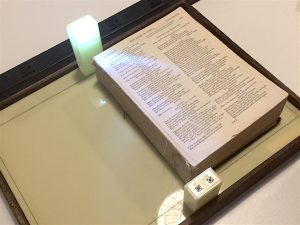Laura Kerry
A play on the notion of electronic texts, the "E-Books" device uses technology (RFID, light and photoresistors, switches, and aprojected p5.js sketch) in combination with print books to concretize the hidden stories embedded in physical pages—when books were acquired, where they have traveled, and what they have signified to those who have carried them.
Description
There’s a popular belief that technology will drive print books to extinction. What if, instead, we could use technology to emphasize the unique experience of reading and possessing physical texts?
The “E-Books” device seeks to do exactly that. When the user places a book affixed with an RFID sticker on the device platform, an RFID/NFC reader in the platform activates a light and p5.js sketch that narrates the story of that particular text. As she passes pages between the light and a light sensor on the opposite side of the page, she triggers slides with writing and images associated with the book—a specific stain or dog-eared corner, an inscription, or a memory associated with a chapter or sentence. The slides will project over the book onto a surface behind the device to underscore the idea that the stories arise from the pages themselves.
Comprised of a collection of books contributed by friends and family, “E-Books” tells the stories of a first-edition Our Bodies, Ourselves, a deteriorating boy scout handbook, books borrowed and lent in friendship and wooing, and other texts that will sit in a stack beside the device for the user to peruse. As a final step, the project will invite users to contribute their own stories about their cherished books on a website. Physical books are more than the writing contained on their pages; “E-Books” harnesses technology to bring to life the secondary stories embedded in them.
Classes
Introduction to Physical Computing ITPG-GT.2301.005

